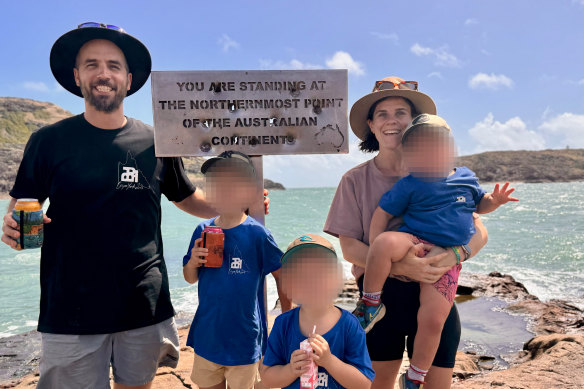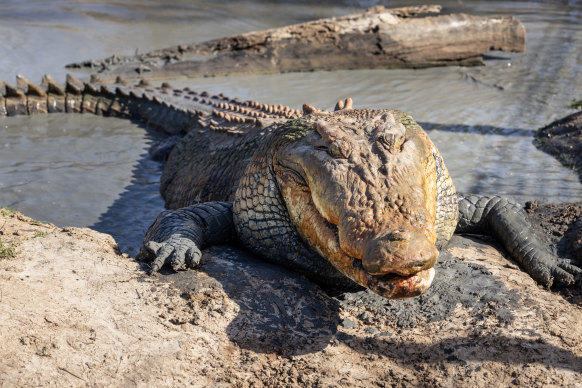This was published 1 year ago
Opinion
There are too many crocs in Australia. Time to unleash the hunters
Brad Emery
Freelance writerOn the final day of my last fishing trip to the isolated town of Weipa in Far North Queensland, the dangers of angling in our nation’s northern waters became very real. Vision emerged from that very morning of a giant croc taking a dog from a beach only a few kilometres away from where we were staying.
It was a sobering reminder of the fact there are wild places on this continent where ill-prepared travellers should fear to tread.

Crocodile attack victim David Hogbin and his family.
It also highlighted what residents and travellers who frequent the Northern Territory and Far North Queensland already know. There is an overpopulation of crocodiles in Australia. Right now, it is estimated there is the equivalent of one crocodile for every 2.5 people living in the Northern Territory, or about 100,000 crocs.
There have been reports calling for the need to address the rise in crocodile attacks following the increase in croc numbers. In 2017, a detailed study found croc-related deaths had risen sharply since hunting was outlawed in 1971.
The report revealed that 14 people died from croc attacks between 2005 and 2014, compared with just 10 deaths in the 33 years to 2004.
In the past two months alone, we’ve seen two fatal croc attacks in our northern waters. In July, a 12- year-old girl was taken from a remote swimming hole in the Northern Territory, police identifying her remains 36 hours after she was reported missing.

The crocodile population in northern Australia has increased significantly.
On the east coast, we recently saw the awful case where NSW “hero dad” Dr David Hogbin fell into hostile waters near Cooktown in Queensland, and was taken by a crocodile. The brave doctor deliberately let go of his wife’s hand to prevent her from also being taken.
The result was not only an outpouring of heartfelt grief and support for the family, but the offending creature was trapped and killed. Unfortunately, this is a familiar reactive response rather than a proactive solution.
It’s a challenge that is not unique to Australia. Other countries have had to deal with dangerous animal populations, including crocodiles, and have been quietly implementing sensible approaches for many years.
One solution that has been employed successfully around the world is for qualified guides to offer hunting safaris for large dangerous animals, like crocodiles.
In the United States and Canada, dangerous animals listed as “game” include native alligators, various species of bears, bison, mountain lions and more. Countries in Africa offer safaris to hunt the native Nile crocodile, with specimens up to three and four metres legally taken.
These safaris are offered to licensed hunters for premium prices, ranging from a few thousand Australian dollars to more than $30,000.
The hunting of these animals is critically monitored and regulated by legislation and overseen by regulatory bodies. The US Department of Fish and Wildlife Service, as well as state-based authorities, oversee such hunting.
There are also industry bodies that help safari outfitters abide by the law, like the Alaskan Professional Hunters Association and the Professional Hunters Association of South Africa.
This heavily regulated hunting industry helps keep the population of particular animals under control, and also provides significant economic benefits for local economies, including additional funds to undertake on-ground wildlife conservation of endangered flora and fauna.
It’s important to note that guided hunting tours already exist in Australia, including for dangerous animals in the Northern Territory and Far North Queensland. However, only introduced species can be hunted, such as water buffalo, wild pigs and banteng bulls.
These guided hunts often provide valuable income for local Indigenous communities who either guide the safari or receive revenue for the hunt occurring on their land.
If the popularity of crocodile and alligator hunting in other parts of the world is anything to go by, demand for these types of adventures in northern Australia would be strong and could be a financial boon for local communities.

Queensland Premier Steven Miles rejected the idea of guided safari hunting in 2017 while he was environment minister.Credit: Jamila Toderas Filippone
In 2017, the Katter Party sought to introduce safari-style hunting of crocs in Queensland, garnering support from traditional owner Alwyn Lyall from the Lakefield National Park area. Mr Lyall said allowing traditional owners to run safari tours would help tackle unemployment as well as help teach people about the culture of First Australians. The measure was rejected by the then Queensland environment minister and current premier, Steven Miles.
Given the significant population of crocs in northern Australia and the success of managed hunting of these animals overseas, it seems ridiculous that qualified guides in our top end are still not allowed to offer crocodile hunting safaris to hunters from Australia and around the world.
Brad Emery is a freelance writer and former staffer in the Howard government.
Get a weekly wrap of views that will challenge, champion and inform your own. Sign up for our Opinion newsletter.